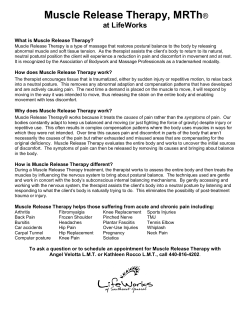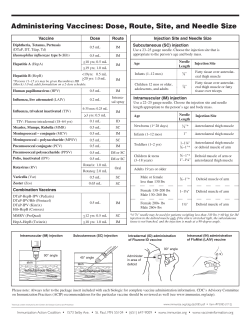
Cricket – Intercostal Injuries (Sidestrain)
Cricket – Intercostal Injuries (Sidestrain) David Connell MBBS MMED FRANZCR FFSEM (UK) Dept’s of Medical Imaging & Physiotherapy Monash University Melbourne, Australia Intercostal muscle injuries or side strain is a clinical diagnosis characterized by sudden onset of pain and point tenderness over the rib cage. Common activities associated with this type of injury include cricket, especially bowling, although also seen with javelin throwing, rowing, and ice hockey [1, 2]. Although an uncommon injury, it is significant for elite athletes because it results in exclusion from competition and prolonged convalescence. It is caused by a tear of the internal oblique muscle from its rib or costal cartilage origin. The aim of this lecture is to describe the normal ultrasound and MRI anatomy of the musculature of the lateral abdominal wall, followed by the imaging findings in a group of cricketers who have presented with this injury. The internal oblique muscle forms part of the superficial covering of the anterolateral abdominal wall. It is one of three large flat muscles in this region that lie under cover of the external oblique muscle. Fleshy fibers arise from the upper surface of the lateral two thirds of the inguinal ligament, the anterior two thirds of the iliac crest, and the thoracolumbar fascia. The posterior fibers pass upward and forward to be inserted into the inferior border of the lower four ribs and costal cartilages and thereafter become continuous with the internal intercostal muscles (Fig. 1). The upper fibers form a short free superomedial border [3]. The fibers arising from the inguinal ligament arch medially across the round ligament in women or spermatic cord in men to form, along with the transverses abdominis, the conjoint tendon. The conjoint tendon inserts into the pubic crest and medial side of the pecten ossis pubis [4]. The remaining fibers of the internal oblique muscle diverge and end in an aponeurosis that broadens superiorly. The upper two thirds of the aponeurosis split into two lamellae that ensheathe the rectus abdominis and reunite at the linea alba. The posterior layer fuses with the aponeurosis of the transversus abdominis muscle and its upper portion inserts into the seventh, eighth, and ninth costal cartilages. The internal oblique muscle derives its nerve supply from the ventral rami of the lower six thoracic and the first lumbar nerves. Normal anatomy of the anterolateral chest wall. Rib stress fractures that have previously been reported in rowers, swimmers, golfers, and canoeists are thought to result from the repetitive forces exerted by the external oblique and serratus anterior muscles [1, 5]. Fractures typically occur in the anterolateral to posterolateral aspects of the fifth to ninth ribs [6]. In addition, external oblique muscle strains have been described in the groin in elite ice hockey players; when correctly diagnosed and treated, prompt recovery and return to full function result [2]. Side strain is caused by an acute tear of the internal oblique musculature where it inserts into the undersurface of the 9th, 10th, or, most commonly, the 11th rib. Patients frequently show detachment of muscle fibers from the cartilaginous cap or adjacent costal cartilage, suggesting that this may be a weak point of attachment. Athletes typically present with a history of acute pain in the anterolateral and posterolateral thoraces. Movements similar to that causing the initial injury often reproduce the pain, as does deep inspiration. On occasions there is concomitant tearing of the external oblique muscle, although clinical findings are similar to tears of the internal oblique alone and there is no apparent increase in recovery time. Normal MRI anatomy in 21-year-old volunteer. A, Surface marker has been placed over region of clinical concern and axial fast spin-echo image (TR/TE, 4,000/30) has been obtained. External oblique muscle (open arrow) lies superficial to internal oblique muscle (solid arrow). Sagittal oblique muscle scans are plotted from axial image. B, Sagittal oblique muscle fast spin-echo image (4,000/30) shows external oblique muscle (asterisk) running downward and forward from 11th rib and costal cartilage (arrow). It has been postulated that the mechanism of injury for internal oblique muscle strain is sudden eccentric contracture with rupture of muscle fibers. Movements associated with bowling (cricket), cause lengthening of the muscle, which is then subjected to superimposed eccentric contraction. In bowlers the muscle tear occurs on the non-bowling arm side. For example, in a right-handed bowler, the left arm is initially hyperextended and then forcefully pulled through to allow the right arm to follow through and release the ball. In the hyperextended position, the internal oblique muscle on the left side can be assumed to be at maximum tension or eccentric contraction. The sudden vigorous motion from this eccentric contraction or pull through that allows the dominant shoulder to flex and release the ball is the probable point at which the internal oblique muscle is likely to rupture. A similar mechanism can be proposed for other throwing sports [7, 8]. A high percentage of type II or fast twitch fibers may also be a predisposing factor to tearing [9, 10]. The mechanism for injury in rowing is different: the shoulder is behind the hips and the scapula is fully retracted. During this action and at exhalation, the internal oblique muscle is assumed to be at maximum tension, again leaving it susceptible to injury. This is also the case for the serratus anterior muscle, which, at a different phase of the stroke, undergoes an eccentric contraction and has been shown to be avulsed at its origin at the ribs via a similar mechanism [1]. MRI appears to be a sensitive test for evaluating side strain injury, showing an abnormality in all patients who had a clinical suspicion of a muscular tear. We find that sagittal oblique muscle images are the most useful for assessing the degree of muscle injury. These are best plotted from the axial scans. Because of the superficial nature of the injury, ultrasound is an ideal modality for identifying the tear, particularly in the presence of blood fluid products. The athlete can typically pinpoint the site of muscle injury. Sonography is best performed with the patient lying supine with the arm draped over the head. Ultrasound is also very useful for monitoring healing and also to guide injections. The internal oblique muscle has a wide origin and varied fiber direction and hence it does not retract far. Muscle defects at the rib or costal cartilage typically range from 10 to 35 mm in size, and the length of tear commonly equates to the severity of the muscle injury. Stripping of the periosteum occurs as the muscular attachment is avulsed from the osseous or cartilaginous origin; this can result in excessive haemorrhage even though the muscle tear may be low grade. The presence of hematoma often aids in the identification of the site of muscle injury, although the signal intensity of haemorrhage is altered with different sequences and time [11]. Certain technical aspects should be considered. Tearing of the internal oblique muscle results in diaphragmatic splinting, which in turn prevents excessive respiratory excursion. This minimizes degradation of MR image quality possible through motion artifact. In asymptomatic individuals and patients with chronic injuries, respiration can interfere with image quality. Fast spin-echo techniques help to decrease respiratory artifact through multiple rephasing, in addition to decreasing imaging time, without loss of resolution or contrast. Use of a surface coil increases the signal-to-noise ratio, enhances spatial resolution, and increases the conspicuity of the lesion. The neurovascular bundle runs beneath the rib, and this linear band of high signal should not be confused with an internal oblique muscle tear. We find the most useful way of discriminating internal from external oblique muscles is the orientation of muscle fibers. External oblique muscle fibers run forward and downward, almost perpendicular to the orientation of the internal oblique muscle, which runs downward and backward. Because it arises from the outer surface of the rib, the external oblique muscle lies superficially to the internal oblique muscle and is not usually seen in the same imaging plane as the rib. Both muscles are thin sheets, even in athletes, and accurate imaging requires a precise technique. In difficult cases, recourse to sonography may be useful, as we found in making it vulnerable to rupture. 31-year-old male cricket bowler with onset of chest wall pain after completing bowling action. A. Sagittal oblique muscle fast spin-echo image (TR/TE, 4,000/30) shows detachment of muscle fibers from undersurface of left 11th costal cartilage. Hematoma fills defect. B. Axial fast spin echo image (400/30) obtained 3 months after A shows hypertrophied mass of scar tissue (arrow) that was subsequently resected at surgery. Rectus abdominis tears are another common injury of the abdominal wall seen in cricketers, and is one of the differential diagnoses to consider. These are also commonly seen in bowlers with eccentric contraction. Typically, they occur without warning, but can be quite extensive and debilitating when they strike. Tears typically involve the deep epimysial surface, but may affect the entire muscle. Bleeding can be quite extensive. Time out from competition can be up to several months. References 1. Karlson KA. Rib stress fractures in elite rowers: a case series and proposed mechanism. Am J Sports Med 1998;26:516–519 2. Lacroix V, et al. Lower abdominal pain syndrome in national hockey league players: a report of 11 cases. Clin J Sports Med 1998;8:5–9 3. Sinnatamby CS, ed. Last’s anatomy, 10th ed. Edinburgh: Churchill Livingstone, 1999:215–220 4. Davies DV, Langmani XX, Green XX. Gray’s anatomy descriptive and applied, 33rd ed. City: 1982:621–622 5. Taimela S, Kujala UM, Orava S. Two consecutive rib stress fractures in a female competitive swimmer. Clin J Sport Med 1995;5:254–257 6. Gaffney KM. Avulsion injury of the serratus anterior: a case history. Clin J Sport Med 1997;7:134–136 7. Garrett WE Jr. Muscle strain injuries: clinical and basic aspects. Med Sci Sports Exerc 1990;22:436–443 8. Thomas JS, Lavender SA, Corcos DM, Andersson GB. Trunk kinematics and trunk muscle activity during a rapidly applied load. J Electromyogr Kinesiol 1998;8:215–225 9. Garrett WE Jr. Muscle strain injuries. Am J Sports Med 1996;6[suppl]:2–8 10. Palmer WE, Kuong SJ, Elmadbouh HM. MR imaging of myotendinous strain. AJR 1999;173:703–709 11. Bush CH. The magnetic resonance imaging of musculoskeletal haemorrage. Skeletal Radiol 2000;29:1–9 12. Obaid H, Nealon A, Connell DA. Sonographic appearance of sidestrain injury. AJR 2008 Dec: 191(6): 264-7 13. Connell DA, Jhamb A, James T. Sidestrain: a tear of the internal oblique musculature. AJR 2003 Dec: 181(6): 1511-7
© Copyright 2025
















